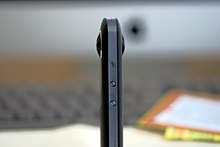Omni directional cameras refer to cameras which have a larger field of view than the normal cameras (more than 180 degree and ideally 360°). This includes cameras with horizontal 360° field of view(FOV) and cameras with FOV spanning a 360° horizontal and more than 90 (ideally 180) vertical field of view(FOV).[1]
Ever imagined how we can get a 360° field of view ?
An omnidirectional camera (from omni, meaning all) is a camera with a 360° field of view in the horizontal plane, or with a visual field that covers a hemisphere or (approximately) the entire sphere.
Figure1 - Example of an omni directional camera using mirrors. (souce-wikipedia ) [2]
1. Camera 2. Lower mirror 3. Aperture 4. Glass housing 5. Cover and upper mirror
There are designs proposed to achieve a 360° field of view.
Cameras which use only special lens to refract light such that the field of view is more than 90° vertically and 360° horizontally. One common example of such type of camera is a fisheye camera.
Figure 2 - Image of a fisheye camera. (source - wikipedia) [3]
Cameras which use a combination of lens (to refract light) and mirrors (to reflect light) with a normal camera to generate 360° horizontal and more than 90° vertical field of view.[1] Figure 1 is an example of a catadiotric camera.
Cameras which consist of two fisheye cameras placed facing away from eachother and each one has a FOV that can span more than a hemisphere. Images from both cameras are stitched to get the full 360° image. This configuration is commonly used in the 360° cameras available in the market.
Figure 3 - Image of a 360° camera with two lenses. (source - wikipedia) [4]
Cameras which consist of more than two cameras with overlaping field of view.[1] One example of such type of camera is throwing camera "panono"[5]. Image from all the cameras is captured at the same time and then stitched to get the full 360° image.
Figure 4 - Image of panono polydioptric camera. (source - wikipedia) [6]
Read this paper[1] on Omnidirectional cameras to know more about different ommni directional cameras
[1] Scaramuzza, Davide. (2014). Omnidirectional Camera. Computer Vision: A Reference Guide, Editors: Katsushi Ikeuchi, ISBN: 978-0-387-30771-8 (Print) 978-0-387-31439-6 (Online), Springer, April, 2014
[2] https://en.wikipedia.org/wiki/Omnidirectional_camera
[3] https://commons.wikimedia.org/wiki/File:Nikon_1_V1_%2B_Fisheye_FC-E9_01.jpg
[4] https://upload.wikimedia.org/wikipedia/commons/thumb/d/d5/Ricoh_Theta_S_camera.jpg/220px-Ricoh_Theta_S_camera.jpg
[5] Omnidirectional cameras https://en.wikipedia.org/wiki/Omnidirectional_camera


